It is a fact that documenting a crime scene is very important for any police investigation, as once the area gets reopened to the public it is hard to go back and find further evidence without it being contaminated. Roswell Police in New Mexico have taken a technological initiative and invested in 3D scanners to preserve a 3D rendering of an area as evidence.

The police department acquired the scanner made by Faro 3D for a cost of $86,000, making them one of the first departments to own the cool gadget we usually only see in episodes of CSI and suchlike.
The 3D scanning device can provide captures down to an accuracy of just "a couple of millimetres" and allows investigators to look over the area from multiple angles long after the initial inspection, says Scott Stevenson, a Roswell Police Detective. "It's going to give the judge and the jury a very accurate graphical image of what the scene consists of," he added.
Possible issues that could come with these high tech documenting methods could be the reliability of the virtual image, which is subject to post-fact manipulations, and famous crime scene scans being leaked to the public. But adding up the pros that come with the technology, the benefits and value of having such convincing clear visual evidence could easily counterbalance any possible issues.

The Verge also noted that investigators in Georgia are using similar technology, from famous camera manufacturer Leica, which records scenes in both 2D and 3D.













